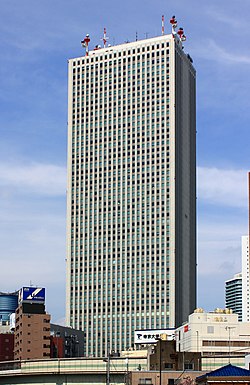Sunshine 60
| Sunshine 60 | |
|---|---|
| サンシャイン60 | |
 |
|
| General information | |
| Type | Mixed-use |
| Location | 3-1-1 Higashi-Ikebukuro Toshima, Tokyo, Japan |
| Coordinates | 35°43′46.5″N 139°43′4″E / 35.729583°N 139.71778°ECoordinates: 35°43′46.5″N 139°43′4″E / 35.729583°N 139.71778°E |
| Construction started | July 1973 |
| Completed | 1978 |
| Opening | March 1978 |
| Height | |
| Roof | 239.7 meters (786 ft) |
| Technical details | |
| Floor count | 60 above ground 5 below ground |
| Design and construction | |
| Architect | Mitsubishi Estate Co. |
Sunshine 60 (サンシャイン60 Sanshain rokujū?) is a 60-story, mixed-use skyscraper located in Ikebukuro, Toshima, Tokyo, adjoining the Sunshine City complex. At the time of its completion in 1978, the 239.7 m (786 ft) building was the tallest in Asia, a title it held until 1985 when it was surpassed by the 63 Building in Seoul. Sunshine 60 was also the tallest building in Tokyo and Japan until the Tokyo Metropolitan Government Building was completed in 1991.
Sunshine 60's foundation is made of reinforced concrete. The lower segment of the building is also reinforced concrete with a steel skeleton. The upper tower is a steel skeleton with "slitted shear walls". These unique walls were inserted between columns in the core, allowing the walls to conform to deformations in the steel frame caused by earthquakes and wind shear helping to assure structural integrity. A rigid framing structural system creates the frame. Mechanical equipment is located directly above the core of the structure on its rooftop.
Sunshine 60 was erected over the site of the destroyed Sugamo Prison, famously used to hold senior Japanese war criminals during the occupation. On December 23, 1948, seven high-ranking, convicted war criminals (including former Prime Minister Hideki Tojo) were hanged at the prison. It was also the site of the hanging of Soviet spy Richard Sorge during the war. In popular modern lore, the area is rumored to be haunted.
...
Wikipedia
